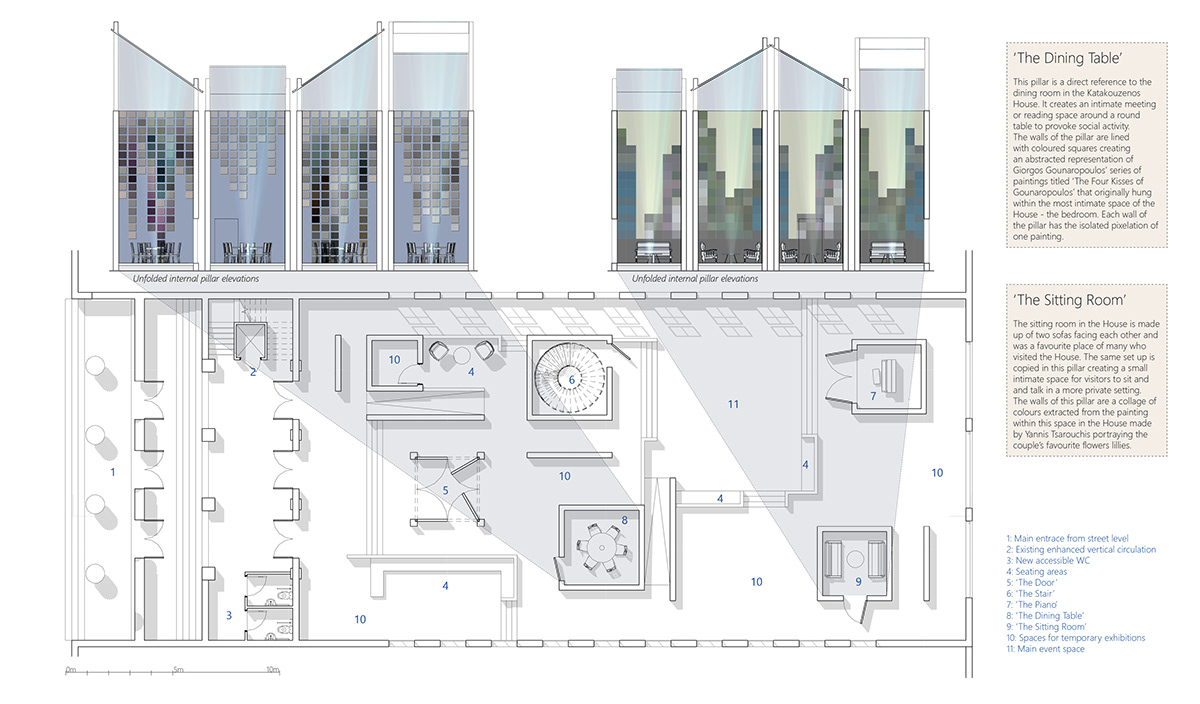Latent Syntax
MArch 2 | Design Studio B | Interface: Re-territorialising the House Museym
Author: Jakub Raspl
University of the West of England, Bristol
Location: Athens, Greece
The Katakouzenos House is located in central Athens, in an apartment building with its main salon overlooking the Hellenic Parliament building at the top of Syntagma Square. This relationship is already setting out an interesting conversation between the place of political power and the intellectual power house that the Katakouzenos and 30’s generation were.
The apartment itself is made of two neighbouring flats in two separate buildings where after the couple moved here in the 1960’s, they connected them and created a private and social space in the front and Angelos’s office in the back with its own separate entrance.
The focus of this research will concentrate on the main living room area and adjacent dining room. It is these areas that tell the stories I am attempting to uncover.
The house preserves the spirit and intentions of people who had a deep influence on the Greek identity in the 20th century. The objects kept in the house, particularly the art of important Greek artists of the last century, were not purchased but given to the couple as gifts, tokens of friendships and gratitude. They include portraits of the couple and paintings that refer to them, their lives and interests. They hold great artistic importance but also an emotional value and have a symbolic power for the inhabitants of the house. (Peloponnissiou, 2001)
The apartment itself is made of two neighbouring flats in two separate buildings where after the couple moved here in the 1960’s, they connected them and created a private and social space in the front and Angelos’s office in the back with its own separate entrance.
The focus of this research will concentrate on the main living room area and adjacent dining room. It is these areas that tell the stories I am attempting to uncover.
The house preserves the spirit and intentions of people who had a deep influence on the Greek identity in the 20th century. The objects kept in the house, particularly the art of important Greek artists of the last century, were not purchased but given to the couple as gifts, tokens of friendships and gratitude. They include portraits of the couple and paintings that refer to them, their lives and interests. They hold great artistic importance but also an emotional value and have a symbolic power for the inhabitants of the house. (Peloponnissiou, 2001)
Peloponnissiou makes an argument that supports the importance of the Katakouzenos House within its local and social context. She argues that Athens seems to be losing its recent landmarks that create pockets of history showcasing the intellect, thinking and stories of the 20th century. She states that ‘The Katakouzenos House is one of these landmarks, a place of memory full of meaning and charm, a lived place open to contemplation and calling for thoughtfulness.’ She then concludes her argument by saying that ‘...modern metropolises do not only need brand new cathedrals of culture and power; they also need small chapels of inspiration and intimacy, where the past can be relived and the future anticipated.’ (2001)


The initial interface prototype was an attempt to interrogate the house and its art collections and reproject them inside of the old stock exchange hall in a form of a gallery space. The idea involved translating the form of each piece of art into an extruded pillar. The extrusions were then arranged into the space of the stock exchange and created a two storey exhibition space.
Each extrusion would be treated the same way on the exterior, however, the internal wall of each pillar would be curated into a collection of stories that people of the city bring in.
Each extrusion would be treated the same way on the exterior, however, the internal wall of each pillar would be curated into a collection of stories that people of the city bring in.


A physical model of one of the pillars was constructed as a prototype. This helped to establish the way artwork can be reprojected through the pillar up into an angled mirror and reflected onto a flat surface. In this way, the pillar could have a projection of a live feed directly from the Katakouzenos House (for each pillar relating to different artwork).

The model was then further developed after closer consideration of the way the art is referenced. The main goal is to find a way create an abstracted way of referencing the artist and art within a different territory. This process of deterritorialisation is defined by Deluze and Guattari as a process of dis-attaching the territory of an existing establishment which allows for frontiers to be opened up and show differences. (Crispin, 2019) It can be understood and used as as description of a cultural process in which the interruption between the social and geographical indicates a new era of unplaced human interplay. (Elden, 2004) Deterritorialisation was, in this case used to develop the pillar into a more interactive representation of the art and the final iteration of the interface was created to form the new gallery space (see next pages).













